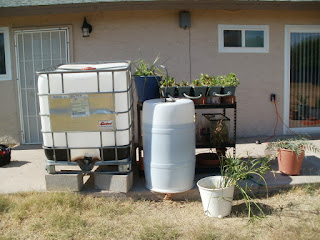 |
| A king stropharia mushroom growing among the carrots in my garden system. |
Viewing the world as an engineer, as I do, I tend to look at
revelations and discoveries from the viewpoint of how they can be utilized to
help solve real problems. Living soil is no exception. As I mentioned in my last post, living soil is excellent at balancing the chemistry and managing nutrient
loads. But what can this insight be used for? How can it be used to make our
lives better? A couple of years ago, I decided to combine aquaponic system
design with the power of living soil. The success of the system has been a
little surprising to me, even with my high hopes. The soil has proven to be
very adept at balancing an aquatic system as well as its own and doing a great
job of processing and retaining nutrients for the plants. Allow me to share two
stories of things I have observed my system doing:
Story 1
 |
| Garden System Version 1.0 |
When I first built my system, I used a small aquaponics
system with hydroton (expanded clay pellets) media and a 55 gallon sump tank.
This was outside in June in Phoenix ,
Arizona
Finally, I managed to scrape together enough money and time
to build my large garden bed. It is 4 feet by 8 feet and I filled it with a
mixture of coconut fiber, wood (mostly spent mushroom logs), perlite, and
compost. Then I added a generous number of worms before planting it.
Immediately the soil sprung to life and began doing what soil is supposed to
do. Within a matter of days the water dropped to a pH of 7.0. Over the next
several months of intense heat and intense water loss and mineral
concentration, it balanced out and eventually reached equilibrium at a pH of
7.6. This is actually a pretty good level for both the fish and the plants and
it held that pH for almost a year without any assistance. The living soil in
the garden, with plenty to eat, did its job and balanced the chemistry of the
whole system, water included.
Story 2
 |
| My poor, sickly basil |
Last spring, as the plants grew, I started noticing a nutrient
deficiency. While most of the plants were clearly suffering from it, it was
obvious that certain plants, like squash and basil, had it the worst. As new
leaves grew, they would come out white, completely devoid of the necessary
chlorophyll. I looked up the nutrient deficiency on my charts, as each
deficiency has its own symptoms, and discovered it was definitely an iron
deficiency and possibly a magnesium deficiency on top of that. So I added some
chelated iron to fix the iron issue and some Epsom salts to fix the magnesium
problem. I added a tablespoon or so of each every 2-3 weeks. After about a
month of treatment, the white leaves stopped appearing and the plants resumed
vigorous growth.
I continued the treatments for a month or so after the
plants recovered, just to make sure they were going to be okay, and then I
stopped adding the supplements. Not long after that, the weather warmed up. I
had some nearby plants that were in containers, but outside my closed system.
Rather than try to remember to water them twice a day, I hooked up a side line.
Every time my system watered itself, a drip line also watered the container
plants from the fish tank. An added benefit of this was that it prevented the
buildup of mineral salts in my tank water. However, it also meant that all
those great dissolved nutrients in the water were also lost. Now, more than six
months have passed and there have been no return of the symptoms of nutrient
deficiency. Since the soil is all the same but the water is all different, that
means that the living soil snatched up all the nutrients it could get while
they were plentiful and have been feeding them to the plants as needed.
I really think that the utility of living soil is one that
is worth exploring further and including in more and more projects.


Great info!
ReplyDelete